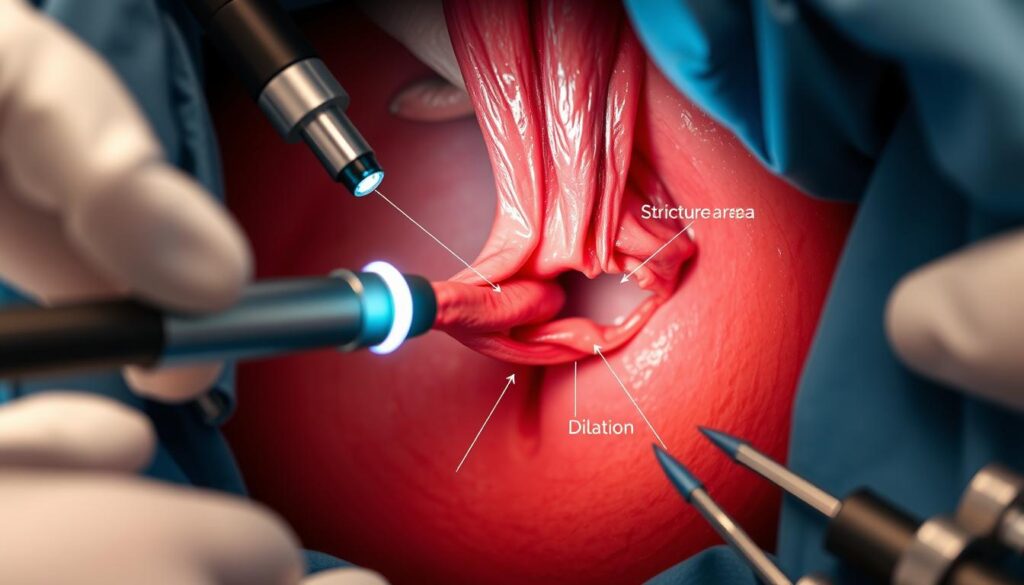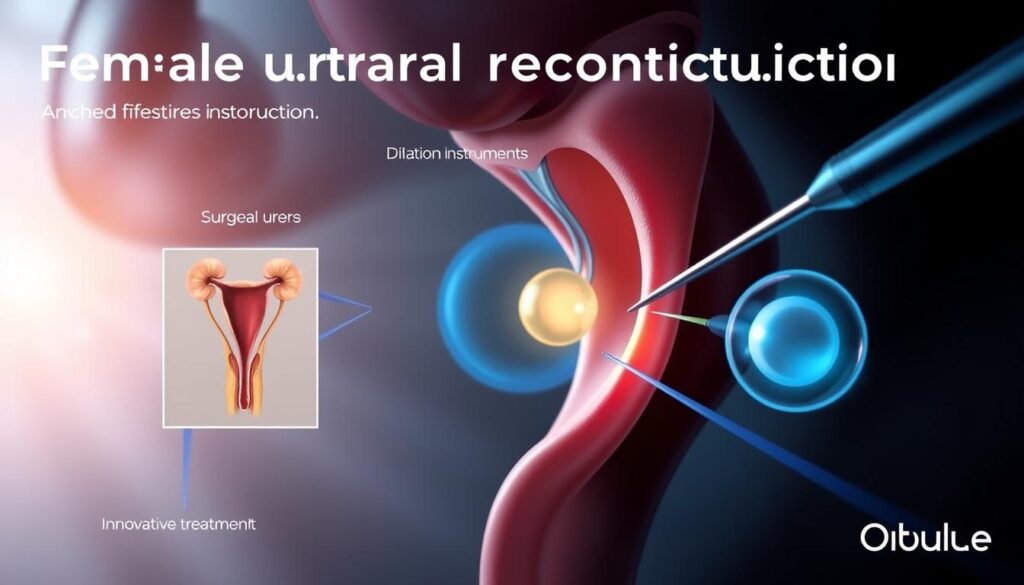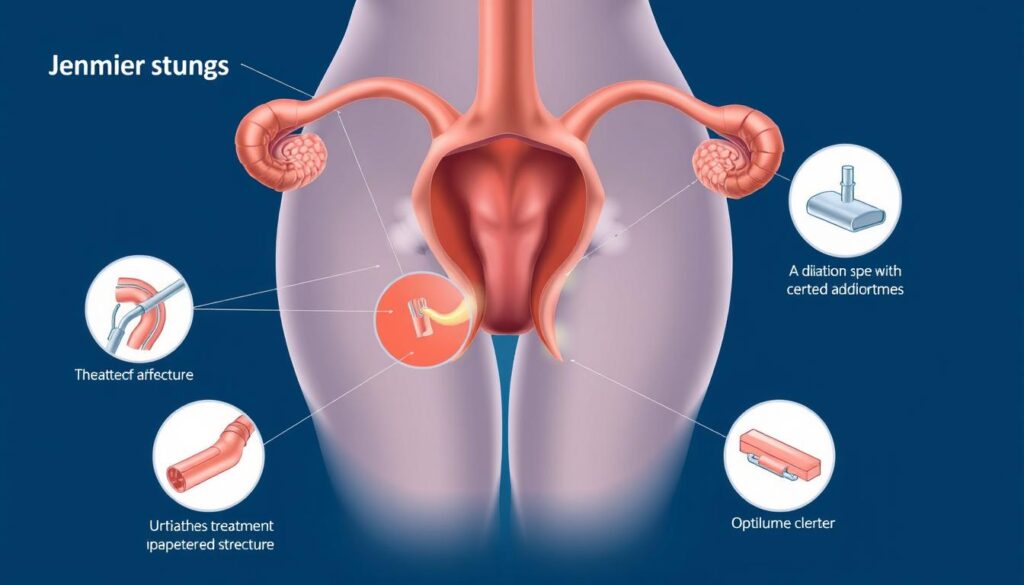Did you know that women urethral strictures are less common than in men? Yet, when they do happen, they can really affect your life. Studies show that in Western countries, 41% of these strictures are caused by unknown reasons, and 35% are caused by medical procedures12.
When the urethra narrows, it can cause many urinary problems. This can make everyday life very hard. This article will guide you through the world of women urethral stricture disease. We’ll look at what it is, why it happens, its symptoms, and the best treatments available today. This includes new methods like Optilume and urethra dilation.
Knowing about these topics can help you make better choices for your health. It’s important to understand your urologic conditions well.
Key Takeaways
- Women experience urethral strictures less frequently than men.
- Idiopathic and iatrogenic causes are the primary contributors in Western regions.
- Symptoms can include urgency, slow stream, and urinary tract infections.
- Urethral dilation and surgical options like urethroplasty are effective treatment methods.
- Recent advancements, such as Optilume, are enhancing treatment efficiency.
Understanding Female Urethral Stricture Disease
Female urethral stricture disease is a tough issue for many women. It causes a big narrowing of the urethra, often from scarring. This makes it hard to urinate. The anatomy of the female urethra is different, leading to unique causes of strictures compared to men. Factors like past surgeries, trauma, and inflammation from urinary tract issues contribute to it.
Definition and Anatomy
The female urethra is shorter than the male one, about 4-5 cm long. This makes women more prone to certain urological problems. Despite its short length, it’s vital for bladder function and urine flow. So, any issue with urethral narrowing in females can cause big problems, like bladder outlet obstruction.
Prevalence in Women
Urethral strictures are rare in women, affecting 0.1% to 1% of those with urinary issues. Only 81 out of 250 studies focused on female urethral stricture, showing it’s less studied than in men3. Also, about three-quarters of strictures come back after treatment, making ongoing care key4.
Impact on Quality of Life
The effects of female urethral stricture can be huge, impacting daily life and mood. Many women see a big drop in quality of life due to pain, urgency, and infections. This chronic issue can cause a lot of emotional pain, making effective treatments and surgery very important.
Common Causes and Risk Factors
Urethral stricture can happen for many reasons. Most cases have no known cause. But, injuries from surgeries, catheter use, and radiation can cause it. Even pelvic fractures can lead to urethral damage.
In women, urethral strictures are less common. This is because their urethra is shorter. Yet, over 5,000 people in the U.S. are hospitalized for this each year. Men are more affected, with over 1.5 million clinic visits5. Women may experience painful urination and swelling due to strictures6.
Childbirth can also cause urethral problems. Infections and long-term inflammation increase the risk. Knowing these causes helps in early detection and better treatment.
Signs and Symptoms of Urethral Stricture in Women
Women with urethral stricture face many symptoms that can change their daily life. It’s important to know these symptoms for early diagnosis and treatment. Symptoms can be physical, urinary, or related to other conditions.
Physical Symptoms
Physical signs of urethral stricture include pelvic pain and weak urine flow. You might also feel more urgency and need to urinate more often. The pain can get worse when you try to urinate or empty your bladder fully.
Blood in your urine or trouble urinating are serious signs that need quick medical help7.
Urinary Complications
Women with urethral strictures often have urinary complications. You might find it hard to start urinating or have a weak stream. Urinary retention can also happen, needing careful management to avoid serious problems.
Studies show that these strictures can lead to more urinary tract infections. This increases your risk of other health issues7.
Associated Conditions
Urethral stricture can lead to other conditions. Chronic inflammation and recurrent urinary tract infections are common. These can cause ongoing discomfort and health problems.
Managing the strictures can help reduce these issues. It can improve your quality of life8.
Diagnostic Procedures and Evaluation Methods

If you think you might have a female urethral stricture, getting a thorough check is key. This usually starts with a urethroscopic evaluation. It lets doctors see the urethra and find any blockages directly.
A retrograde urethrogram (RUG) is also vital. It uses X-rays to show the urethra after injecting contrast material. This helps figure out where and how long the stricture is.
Video urodynamics is used too. It measures the urinary flow rate and checks how the bladder works. These tests help understand urine flow and any blockages.
Checking the post void residual urine volume is also crucial. It shows how much urine is left in the bladder after you’ve finished peeing. This helps doctors see if a stricture is causing urinary retention.
Together, these tests give a clear picture of the stricture’s severity and type. They help doctors plan the best treatment. Each test is important for understanding the urinary tract condition fully. This ensures the best care for those with urethral stricture symptoms91011.
Women Urethral Stricture Disease, Urethra Stenosis, Urethra Dilation, Optilume
Understanding modern treatments for urethral stricture disease is key for women dealing with it. Urethra dilation is a common treatment that helps widen the narrowed urethra. This method aims to ease symptoms and improve urine flow.
Those with urethral stricture may face discomfort or serious issues like urinary tract infections and trouble fully emptying the bladder12. It’s vital to manage this condition well, especially as more older people are affected13.
Modern Treatment Approaches
Modern medicine has changed how we treat urethral reconstruction. The optilume urethral dilator is a new, less invasive tool. It uses drug-coated balloon technology to widen the urethra and apply medication to the stricture site.
This approach reduces the chance of the stricture coming back13. It shows a move towards treatments that focus on improving patient results.
Technology Advancements
New technology has led to better ways to treat urethral stenosis. The optilume urethral dilator is at the forefront of these advancements. It causes less damage and allows for quicker recovery than old surgical methods.
Research keeps going to make these treatments even better. This ensures patients get care that fits their unique needs.
Conservative Treatment Options
For many patients, especially those with mild cases, conservative treatments are key. Active surveillance is a big part of this. It lets doctors keep an eye on the condition without rushing into treatment. This is great for people who don’t have severe symptoms yet.
Urethral dilation is another non-surgical choice. It uses special tools to widen the urethra. This can help symptoms and improve function without surgery. Studies show it works well for many women with pelvic floor issues.
Urethral stenting is also an option for some. It involves putting a stent in the urethra to keep it open. But, it’s important to think about each patient’s health and needs carefully.
Choosing a conservative treatment shows the value of teamwork in healthcare. Doctors work together to find the best plan for each patient. This approach helps improve both urinary function and quality of life.
| Treatment Options | Description | Indications | Advantages |
|---|---|---|---|
| Active Surveillance | Monitoring condition without immediate treatment | Mild stricture cases | Non-invasive, avoids unnecessary interventions |
| Urethral Dilation Techniques | Non-surgical widening of the urethra | Moderate to moderate symptoms | Effective relief, lower complication rates |
| Urethral Stenting | Placement of a stent to maintain urethral patency | Selected patients with recurrent strictures | Can provide durable relief |
Conservative treatments for urethral stricture disease are a solid base for managing this condition. They help relieve symptoms and focus on the patient’s overall health14.
Minimally Invasive Procedures
Minimally invasive procedures are key in treating urethral strictures in women. They include urethra dilation surgery and internal urethrotomy. These methods help reduce symptoms, speed up recovery, and lessen discomfort.
Urethral Dilation Techniques
Urethral dilation is often done as an outpatient procedure, avoiding the need for hospital stay15. It usually takes less than an hour, showing its quick and efficient nature15. Most people can stop using a catheter a few days post-procedure, indicating a fast recovery15.
The procedure is moderately painful, but pain relief options are available, including over-the-counter meds15. Pain from the dilation typically fades within a few days, showing it’s short-lived15.
Internal Urethrotomy
Internal urethrotomy is another minimally invasive method. It involves making a small incision in the urethra to remove the stricture. This approach offers a clear view of the stricture site through endoscopy, often improving urine flow, especially in those who’ve tried other treatments without success.
The use of the Optilume drug-coated balloon (DCB) has shown great results, with a 75% success rate and almost no serious side effects8. After a year, 75% of patients treated with Optilume were free of stricture8. The procedure is quick, taking just 15 minutes in an office setting8.
A clinical study showed significant improvement in patients treated with Optilume, with a 75% symptom reduction8. Anatomic success at 6 months was seen in 75% of patients16. Long-term results were also positive, with 68% functional success at 2 years and 67% at 3 years, showing long-term stability16.
Surgical Treatment Options and Urethroplasty

When other treatments don’t work, surgery like urethroplasty is key for women with severe urethral strictures. Urethroplasty removes scar tissue and widens the urethra. It uses tissue grafts based on the stricture’s type. Choosing the right surgery is important for lasting results.
Graft urethroplasty uses biological or synthetic grafts to fix the urethra. It aims for better function and fewer strictures coming back. Studies show it’s a good choice for those with many strictures. New tech like the Optilume® Drug Coated Balloon (DCB) offers a less invasive option. It has shown good results in patient recovery.
In 2021, the Optilume DCB was first used in a urethral stricture procedure in the UK17. It has led to better urinary flow and fewer symptoms for patients8. A study of 127 patients showed big improvements in urinary function after using the Optilume DCB. Symptoms also dropped a lot over three years18.
Recovery and Post-Treatment Care
After treatment for urethral stricture, post-operative care is key. Proper management of urinary catheterization helps with healing. You might feel a burning sensation when you pee, pee more often, or see blood in your urine. These signs are common and usually go away with time.
Most people can get back to normal activities in 1 to 2 days19. Rest when tired, do light activities like walking, and eat normally.
Immediate Post-operative Care
Right after surgery, you’ll get specific instructions from your doctor. It’s crucial to follow up with care to ensure treatment success. Go to all your appointments and ask for help if you have problems.
Drinking plenty of water is also important for your urinary health. Try to avoid constipation and take your medications as advised, especially blood thinners.
Long-term Management
Long-term plans are key to prevent urethral stricture from coming back. Studies show that about 75% of patients stay stricture-free after Optilume treatment for a year20. Keeping hydrated and watching for urinary symptoms can help your health.
Knowing about symptoms like weak flow or painful urination is important8. This way, you can get help quickly if you have any issues.
Potential Complications and Side Effects
It’s important to know about the possible problems and side effects of urethral stricture treatments. Issues like recurrent urinary retention can happen due to scarring or if the treatment doesn’t work. You might also get urinary tract infections after surgery or dilation. Rarely, you could face neurological problems, which is why constant monitoring is key.
After treatments like Direct Visual Internal Urethrotomy (DVIU) or dilation, recurrent urinary retention is a common side effect. This shows the need for careful follow-up care. Studies show that urethroplasty has success rates over 85-90% but can cause urinary symptoms, incontinence, or wound issues21. It’s crucial to tell your healthcare team about any unusual symptoms right away to avoid bigger problems.
Every patient’s experience with urethral stricture treatments is different. This depends on the treatment and the person’s health. Most complications come from how the body reacts to the treatment and post-operative factors. This highlights the importance of a care plan tailored to each individual.
| Complication | Details |
|---|---|
| Recurrent Urinary Retention | Frequent issue post-treatment, may require additional interventions |
| Urinary Tract Infections | Common after surgical procedures, may need antibiotics for treatment |
| Neurological Problems | Rarely occur but are possible; immediate consultation needed |
| Irritative Urinary Symptoms | May arise after urethroplasty. |
| Incontinence | Can be a side effect of urethroplasty, requiring pelvic floor therapy. |
| Wound Problems | Infection or delayed healing, needing further medical attention |
Knowing about these possible complications helps you make better choices about treatment. It also helps you talk to your healthcare team about the risks and benefits1.
Prevention Strategies and Lifestyle Modifications
Your lifestyle choices are key in preventing urinary tract infections and urethral stricture. Doing pelvic floor exercises strengthens muscles that support your urinary tract. This can lower the risk of problems. Drinking enough water helps flush out toxins and bacteria, which also helps prevent infections.
Try to avoid procedures that might hurt your urethra. This can help keep your urinary system healthy. Always talk to a healthcare provider to make these changes work best for you.
These steps can improve your health and make daily life easier. Remember, acting early and taking care of yourself is crucial. Being proactive can greatly improve your overall health2223.
Latest Advances in Treatment Technology
The field of urology is changing fast with new treatment tech. These new methods aim to better handle female urethral strictures. They promise to improve patient results and happiness.
Innovative Surgical Techniques
New guidelines suggest advanced surgical ways, focusing on what’s best for each patient. The Optilume urethral dilator stands out for its success and gentle approach. It’s caught the eye of many in the medical field24.
The ROBUST III trial shows drug-coated balloons work well. They kept the urethra open better than old methods after six months25.
New Medical Devices
New devices are key to better patient care. The Optilume urethral dilator is a big step forward for treating urethral strictures. Z Urology offers custom treatments, making sure each patient gets what they need24.
Using these devices marks a move towards better patient health. It shows a dedication to top-notch urological care.
Long-term Prognosis and Success Rates
Patients treated for urethral stricture disease often have a good outlook. Thanks to new treatments, success rates have gone up a lot. Urethroplasty, a key surgery, gives the best long-term results.
Studies show that 77% of patients who used a special treatment plan with corticosteroids got better26. This plan didn’t cause any extra problems, showing it’s safe and effective26.
New treatments like the Optilume drug-coated balloon show great promise. About 67% of patients did well three years later16. The ROBUST III trial found a 75% success rate at six months, proving tailored treatments work well16.
For those with strictures that keep coming back, this therapy is a good option. It’s less invasive than older methods.
What causes strictures and who they affect matters a lot for success. Most strictures happen in the bulbar area, making early and right treatment key1. Keeping up with follow-ups is also important. It helps catch any new problems and keeps urine flow healthy.
In summary, the field of urethral reconstruction is getting better. New methods track success and improve patient results. By focusing on long-term care, we can help patients keep their urine flow at its best.
Conclusion
Understanding women urethral stricture disease is key to managing it well. This article has covered different treatments, from simple methods to advanced surgeries like the Optilume® Drug Coated Balloon technology. It has shown great results for cases that keep coming back17.
Knowing the symptoms and causes, like idiopathic and iatrogenic factors, helps a lot. It lets you take steps to better your urinary health and overall health1. Working closely with your healthcare team can lead to better results and a better life.
FAQ
What is female urethral stricture disease?
Female urethral stricture disease happens when scarring narrows the urethra. This makes it hard to pee and causes symptoms like needing to pee a lot, feeling a burning sensation, and pelvic pain.
What are the common causes of urethral strictures in women?
Urethral strictures can be caused by injuries during surgeries or when using catheters. They can also happen due to trauma from childbirth or pelvic fractures. Infections or inflammation can also cause scarring.
What symptoms should I look out for if I suspect a urethral stricture?
Look out for symptoms like trouble starting to pee, a weak urine stream, needing to pee a lot, pelvic pain, and UTIs that keep coming back.
How is female urethral stricture diagnosed?
Doctors will check your symptoms and might use tests like urethroscopy, RUG, and video urodynamics. These tests help see how well you pee and if there’s a stricture.
What treatment options are available for urethral strictures in women?
Treatments include watching and waiting, and using tools to widen the urethra. Surgery like urethroplasty and minimally invasive methods like the Optilume urethral dilator are also options.
What is urethral dilation, and how is it performed?
Urethral dilation is a way to widen the narrowed urethra. It’s done using balloons or other tools to help urine flow better.
Are there any potential complications associated with urethral stricture treatments?
Yes, treatments can lead to problems like not being able to pee, infections, and rarely, nerve issues. Watch for any unusual symptoms after treatment.
What lifestyle modifications can help prevent urethral strictures?
To prevent urethral strictures, try pelvic floor exercises, drink enough water, and treat UTIs quickly. These simple steps can help a lot.
What is the long-term prognosis for women with urethral stricture disease?
The outlook is good, especially with today’s treatments. Tailored treatments lead to high success rates in fixing the urethra.
How should I care for myself post-treatment for urethral stricture?
After treatment, you might need to manage a catheter, go to follow-up visits, and follow long-term care plans. This helps prevent strictures from coming back.
Source Links
- Urethral Strictures – StatPearls – NCBI Bookshelf – https://www.ncbi.nlm.nih.gov/books/NBK564297/
- Urethral Stricture Diagnosis & Treatment | Mount Sinai – https://www.mountsinai.org/care/urology/services/reconstructive-urology/urethral-strictures
- Urethral Stricture – AUA Guideline – https://www.auanet.org/guidelines-and-quality/guidelines/urethral-stricture-guideline
- Urethral Stricture – https://www.uclahealth.org/medical-services/womens-pelvic-health/conditions-treated/urethral-stricture
- Urethral Stricture Treatments & Information – https://www.laborie.com/blog/2023/04/12/urethral-stricture-treatment/
- Urethral stricture: MedlinePlus Medical Encyclopedia – https://medlineplus.gov/ency/article/001271.htm
- Urethral Stricture: Causes, Symptoms, and Prevention – https://www.healthline.com/health/urethral-stricture
- Optilume for Urethral Strictures – University Urology Associates – https://uuaurology.com/treatments-and-procedures/optilume-for-urethral-strictures/
- Medical Student Curriculum: Urethral Strictures – https://www.auanet.org/meetings-and-education/for-medical-students/medical-students-curriculum/urethral-strictures
- Approach Considerations, Surgical Therapy, Open Reconstruction – https://emedicine.medscape.com/article/450903-treatment
- Approach Considerations, Imaging Studies, Diagnostic Procedures – https://emedicine.medscape.com/article/450903-workup
- Urethral stricture: what is it, symptoms and treatment | Top Doctors – https://www.topdoctors.co.uk/medical-dictionary/urethral-stricture
- Frontiers | Therapeutic adjuncts in the endoscopic management of urethral stricture disease: past, present, and future – https://www.frontiersin.org/journals/urology/articles/10.3389/fruro.2024.1342941/full
- PDF – https://www.nice.org.uk/guidance/mtg73/documents/450
- What Is Urethral Dilation? – https://my.clevelandclinic.org/health/treatments/25044-urethral-dilation
- Dr. Chee summarizes latest Optilume data in patients with urethral strictures – https://www.urologytimes.com/view/dr-chee-summarizes-latest-optilume-data-in-patients-with-urethral-strictures
- Urethral stricture treatment using Optilume® technology | Top Doctors – https://www.topdoctors.co.uk/medical-articles/using-optilume-for-urethral-stricture-treatment
- ROBUST III study 3-year interim results – https://www.ics.org/2023/abstract/8
- What to Expect at Home – https://myhealth.alberta.ca/Health/aftercareinformation/pages/conditions.aspx?hwid=acg6151
- OPTILUME: Traitement innovateur d’une sténose urinaire – https://www.lescliniquesmaroisurologue.ca/en/procedures/optilume/
- PDF – https://fix8media-echarles.squarespace.com/s/About-your-urethral-stricture-surgery.pdf
- Microsoft Word – P210020-A003 – Urotronic-Optilume – SSED – FINAL-v8.docx – https://www.accessdata.fda.gov/cdrh_docs/pdf21/P210020B.pdf
- Abstracts of the 44th Congress of the Société Internationale d’Urologie – https://www.mdpi.com/2563-6499/5/5/58
- Optilume – Z Urology – https://zurology.com/optilume/
- AUA2023 GUIDELINE PRESENTATION Summary of Urethral Stricture Guidelines Case-based Presentations – https://auanews.net/issues/articles/2023/july-2023/aua2023-guideline-presentation-summary-of-urethral-stricture-guidelines-case-based-presentations
- Is a Course of Intermittent Self-dilatation with Topical Corticosteroids Superior at Stabilising Urethral Stricture Disease in Men and Improving Functional Outcomes over a Course of Intermittent Self-dilatation Alone? A Systematic Review and Meta-analysis – https://pmc.ncbi.nlm.nih.gov/articles/PMC10130070/


